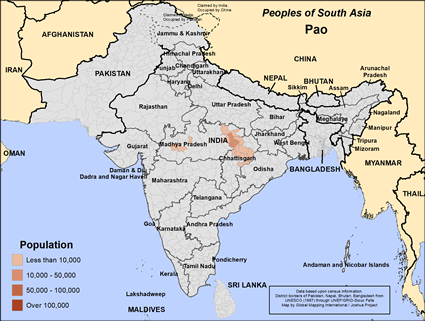India is a complex mosaic of ethnic, linguistic, religious, and social groupings. Because of this diversity, it is extremely difficult to adequately describe any single people group.
We may divide India into four major regions: the Himalayas, the northern river-plains region, the Deccan Plateau, and the Eastern and Western Ghats Mountains. Because of many geographical features, climatic conditions are also widely diverse on both a seasonal and regional basis, ranging from tropical to temperate extremes.
The Pao community stands in the midst of this complexity. They are located mainly in the Satna District of the state of Madhya Pradesh. Their language is a member of the Sino-Tibetan language family. We know very little about their specific lifestyle, especially how they are living in the 21st century.
Most of India's population lives in rural areas and is engaged in some form of agriculture. Many are farmers growing barely enough to survive. Their farms are extremely small and are often very fragmented. The raising of livestock, particularly horned cattle, buffalo, horses, and mules is a central feature of the agricultural economy. Because of Hindu influence, however, they use these animals only as beasts of burden rather than sources of meat.
Indian culture is primarily Hindu-oriented. Many Hindu institutions, including the rigid caste (social class) system, have wide-ranging effects on secular Indian society. We divide Indian society into hierarchical castes which are usually endogamous (marriage only within the caste). Occupation may define castes or by kinship and lineage, although there are some exceptions. Caste is so fundamental to the social organization of India that it prevails in all parts, except some of the tribal populations.
We don't know enough about the Pao community to accurately place them in the caste system. Therefore, we cannot describe their particular lifestyle. It will take researchers to live among them to learn about how they live.
The Pao are virtually all Hindu and follow the basic Hindu customs and traditions. The term "Hinduism" came into use about 1200A.D., but clearly identifying what Hindus believe is difficult. The religion has no founder, no prophet, and no instructional system. It is a way of living much more than a theology; it is a philosophy more than a religion. Contrary to popular belief in the West, Hinduism is not an ancient, fixed set of beliefs. Rather, it is a body of customs, practices, and beliefs that go through major changes every few hundred years.
The majority, though not all, of Hindus believe in a supreme being. Some respect all life and eat only vegetables, while others will gladly eat meat from sacrifices in the temple. To some, their religion is highly personal; to others, it is impersonal. While most Hindus worship Brahman (the creator), Shiva (the destroyer), Vishnu (the preserver), and the goddess Shaktri, they also worship a pantheon of minor gods, their incarnations, spouses or offspring. A belief in reincarnation (continual cycle of death and rebirth) is one of the few unifying features of Hinduism.
There are only a few known Christ followers among the Pao. These believers desperately need materials that will encourage and strengthen them in their walk with the Lord. The Pao people need God's people to pray for his abundant blessings.
Pray that God will send culturally sensitive missionaries who will show them the way to the cross.
Pray for a Christ-ward movement to flourish among this people group in the 2020s.
Pray for the Pao community to be blessed with peace, joy and spiritual prosperity as they follow Jesus Christ.
Pray for their leaders to have dreams and visions that will open their hearts to Jesus Christ and his ambassadors.
Scripture Prayers for the Pao in India.
| Profile Source: Joshua Project |











